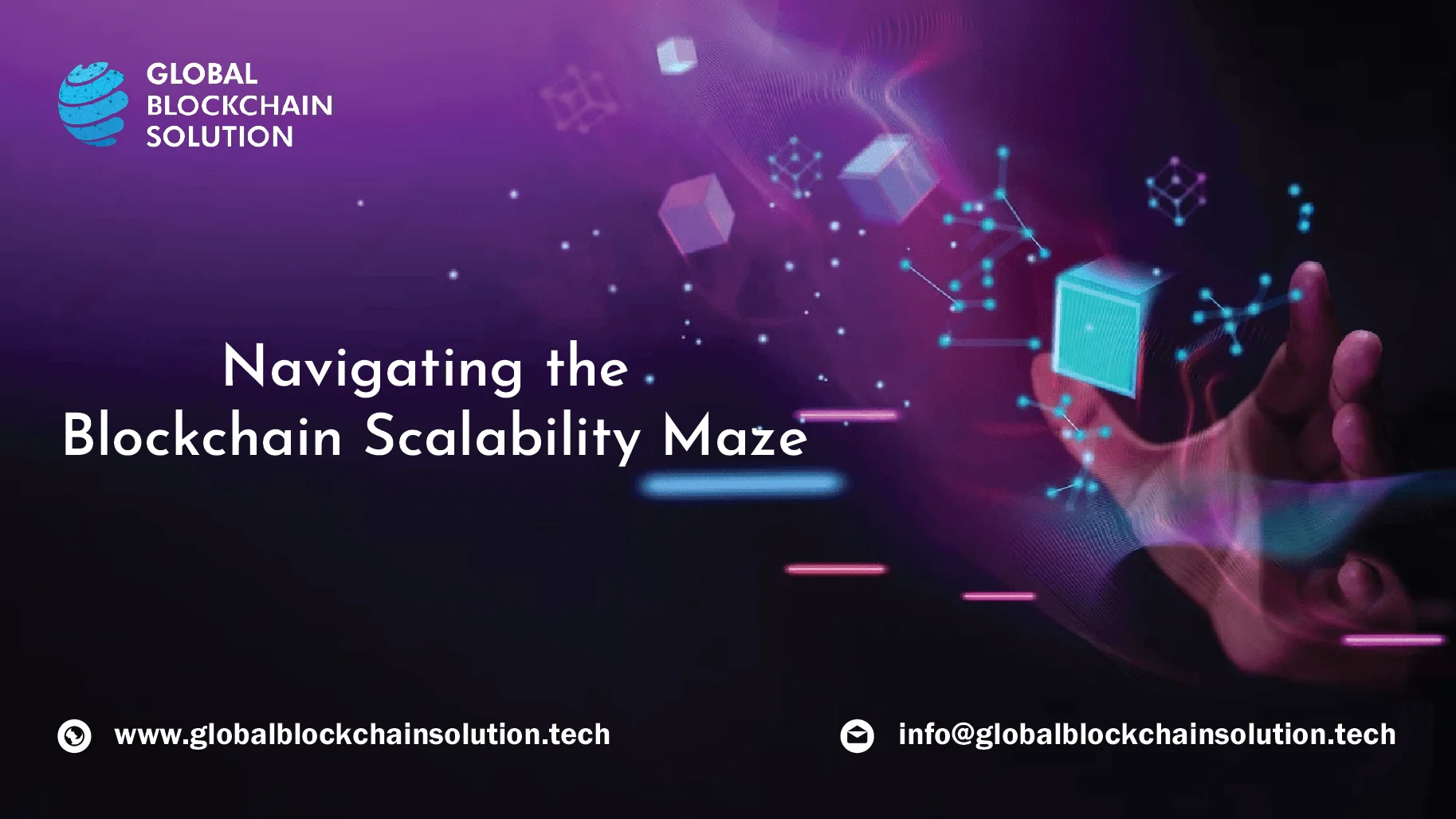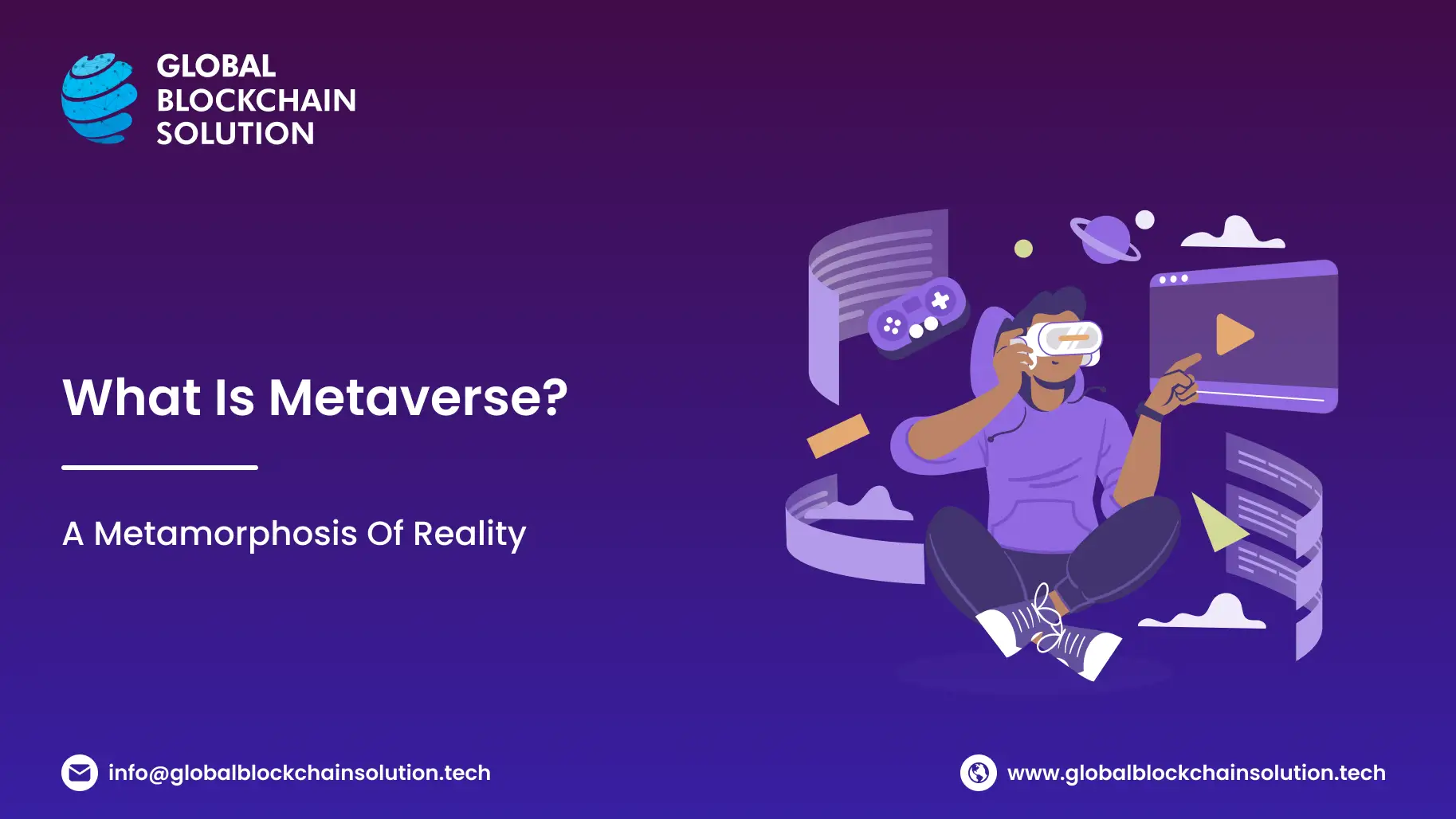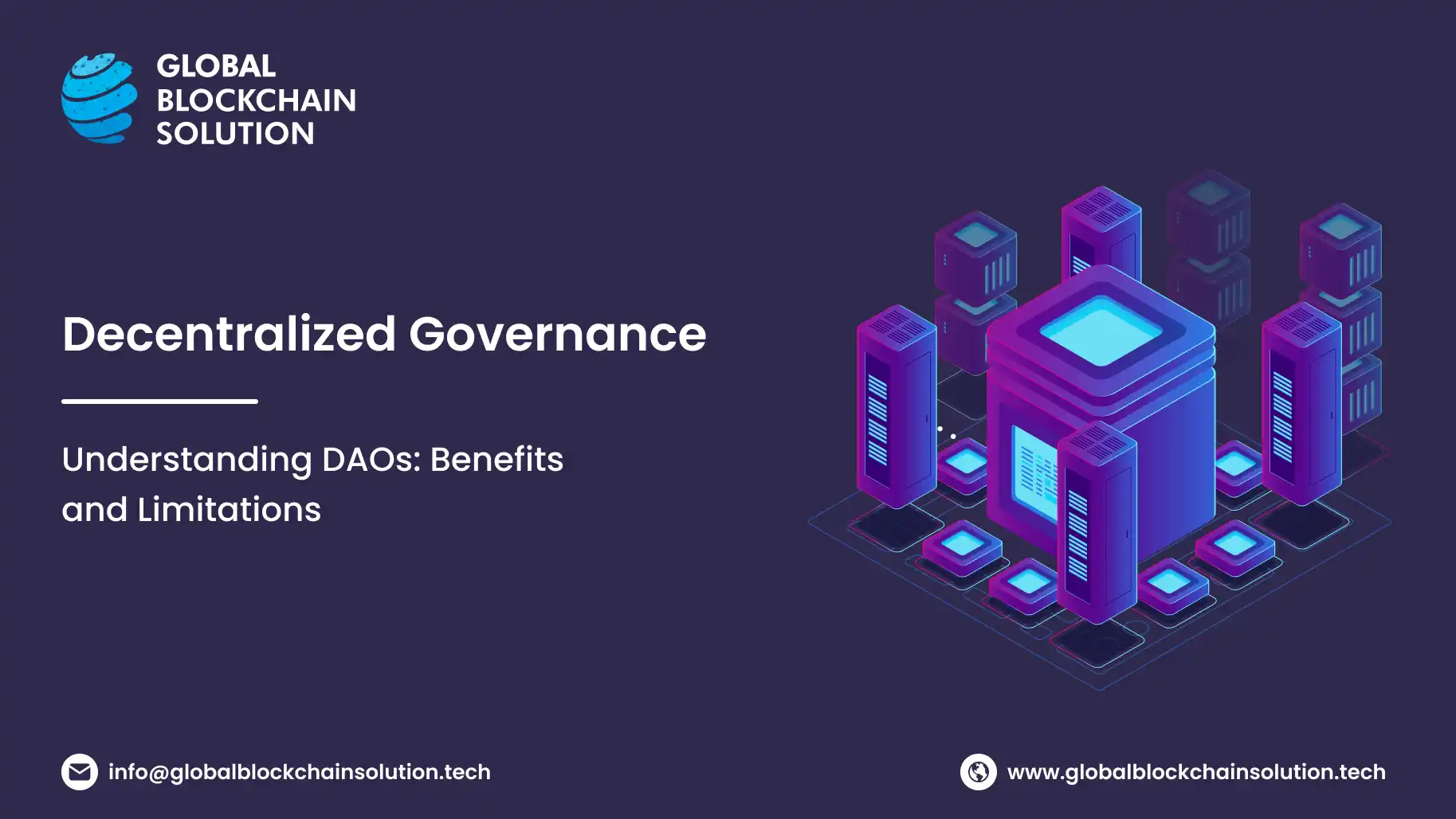Back in 2017, a seemingly innocuous game called CryptoKitties congested the Ethereum network, illustrating the stark limitations of blockchain scalability. Yet, while the event was brushed off by many as a crisis, it underscored the need for blockchains to handle real-world demands without compromising security or decentralization.
Here at Global Blockchain Solution, our firsthand experiences with such real-world events, many lesser-known than CryptoKitties, have sharpened our understanding. It's not just about building a faster or more secure system; it's about constructing a harmonious ecosystem where all three elements of blockchain trilemma coexist, complementing each other.
So, today, let’s unravel the intricate tapestry of blockchain scalability. We'll be drawing from the rich well of insights, events, and facts that have been pivotal in shaping the blockchain landscape as we know it.
This Article Contains:
The Blockchain Trilemma
The blockchain trilemma stands as an embodiment of blockchain technology's most prominent challenges, rooted in three pivotal pillars: scalability, security, and decentralization.

-
Scalability
In today's decentralized finance (DeFi) boom, scalability has taken center stage. With platforms like Uniswap V3 leveraging concentrated liquidity to offer better transaction efficiency, and Optimistic and zk Rollups aiming to enhance Ethereum's throughput, it's evident that adaptability goes beyond just speed. Yet, even these solutions face their challenges. The initial delays of Optimism's mainnet launch and major bugs in it during forks are a case in point.
-
Security
With the increasing value locked in smart contracts, especially in newer platforms like Lido Finance, Aave, and BNB Chain, security breaches have grown both in frequency and magnitude. Security events, such as the 2021 flash loan attack on PancakeBunny on BSC, reiterate the dire need for robust security solutions in an ever-evolving threat landscape. Left unaddressed, they can lead to damages worth billions of dollars along with the associated trust deficit.
-
Decentralization
The rise of DAOs (Decentralized Autonomous Organizations) like Compound and MakerDAO in governance decisions underscores the push for decentralization. Yet, controversies, such as the earlier debate surrounding EIP-1559 within the Ethereum community, highlight the delicate balance between community-driven governance and efficient protocol upgrades.
Also Read: What is Blockchain Trilemma?
Emerging platforms like Polkadot, with its parachain structure, and Avalanche with its subnets, aim to artfully balance the trilemma. These platforms offer innovative solutions to enhance scalability and security while attempting to uphold decentralization. Yet, the recent DDoS attacks such as Avalanche-based Star Arena’s smart contract exploit and DDoS attack underscore that even the newest solutions aren't exempt from facing the trilemma's challenges head-on.
As the blockchain landscape evolves at a breakneck pace, navigating the trilemma requires a blend of technological prowess and community-driven ethos. The goal remains consistent: architecting systems that remain expansive, robust, and unfailingly democratic.
Blockchain Scalability Issues
Blockchain scalability issues are many and, at times, more complex than they may seem. Let’s highlight some of them.
Limited Throughput
One of the core challenges in blockchain technology remains the issue of throughput, specifically the ability to handle a larger number of transactions per second (TPS). The discrepancy between blockchain TPS and that of traditional payment systems is telling:
-
Ethereum 2.0, in its ambitious vision, plans to scale up by introducing sharding, potentially increasing its TPS by multitudes. Even after its Phase 1, the TPS of Ethereum averages from 4 to 32 (including L2s, sidechains, zk Rollups, and validiums.)
According to ETHTPS.info, the maximum TPS recorded on the Ethereum network is of Arbitrum One at 327 TPS. Even with these optimistic projections, traditional giants like Visa, which process on average around 1,700 TPS and can peak at 24,000 TPS during holiday seasons, overshadow this capacity.
-
Solana has garnered attention for its impressive scalability, touting over 50,000 TPS under certain conditions. While promising, such numbers are often achieved under optimal conditions and may not hold under real-world network loads.
Note: Solana is currently handling an average of 4,400 transactions per second, which is one of the highest in the industry.
This divergence in throughput is not merely a metric; it signifies a blockchain's ability to be adopted widely in industries ranging from finance to supply chain, without leading to transaction backlogs.
Transaction Latency
A high TPS is commendable, but if a transaction takes too long to be finalized, the system becomes untenable:
BNB Smart Chain (BSC), another modern blockchain, boasts 3-second block times, marking a significant improvement over its predecessors. Yet, during times of high congestion, even BSC users have experienced delays of more than 5800 seconds (approx.. 97 minutes), 1935 times higher than usual.

High Fees
The Achilles heel of many blockchains, especially during congestion:
Ethereum, even after its multiple upgrades, sees exorbitant gas fees during congestions, with a user paying as much as 64 ETH (approx. $115,000) for a single transaction on 8th May 2023.
For staking-based cryptos, during network congestion, users without enough staked tokens often find it challenging to transact.
Technical Tradeoffs
The balancing act of scalability often comes with strings attached:
Polkadot's parachain structure allows for high scalability by allowing multiple chains to run in parallel. However, this raises questions about the interconnectivity and interoperability of these chains, especially concerning cross-chain transactions.
Layer 2 solutions, such as Optimism and zk Rollups for Ethereum, promise scalability but introduce their own complexities, including the need for users to interact differently with these layers compared to the main chain.
In conclusion, while blockchain technology has made leaps and bounds since its inception, the quest for a system that is scalable, secure, and decentralized remains ongoing. Innovations continue to emerge, but with every solution, new challenges arise, underscoring the dynamic and evolving nature of this space.
Scaling Solutions
The quest for scalability in blockchain has led to the development of varied solutions, each aiming to augment transactional throughput without compromising on security or decentralization. These solutions broadly fall into three categories:
-
On-chain (Layer 1) Solutions: Modifying the Blockchain Protocol Itself
At its core, this strategy aims to tweak the very foundation of the blockchain itself, whether it's how it stores data or how it processes transactions.

Sharding
Used prominently in Ethereum 2.0's roadmap, sharding divides the network into multiple smaller chains (shards) that process transactions simultaneously. This parallel processing increases throughput. However, coordination between shards is complex and can present new challenges.Block Size and Time Adjustments
Solutions like BSC have tweaked these parameters to achieve higher TPS. Yet, smaller block intervals can lead to security concerns, while larger block sizes can impact decentralization, as fewer nodes may be equipped to validate such blocks.Pruning
Older transactions are removed or 'pruned' to reduce the blockchain's size, ensuring more efficient processing and storage. While this aids scalability, it poses challenges for full archival nodes which aim to maintain the complete blockchain history.Also Read: How to Select the Right Blockchain Application Development Company?
-
Off-chain (Layer 2) Solutions: Additional Frameworks for Faster/Cheaper Transactions
The idea here is to offload some of the work from the main blockchain. This is akin to using express lanes or bypasses to avoid traffic.

State Channels
These are private lines between parties, allowing numerous transactions to occur off the main chain. Once complete, the final state is settled on-chain. Raiden Network for Ethereum is a notable example.Plasma
Proposed for Ethereum, Plasma involves creating child chains attached to the main chain. These child chains handle the bulk of transactions, with only essential information submitted to the primary chain, significantly reducing congestion.Rollups
Techniques like zk Rollups and Optimistic Rollups bundle multiple transactions into one. They then only post the resultant state to the main chain. Rollups have become increasingly popular for Ethereum, offering both scalability and reduced transaction costs.
-
Alternative Consensus Models
These are different ways of achieving agreement across the network. Here are a few models that look for quicker or more streamlined ways of achieving consensus.

Delegated Proof of Stake (DPoS)
An iteration of PoS, DPoS allows coin holders to vote for a small number of delegates who will be responsible for validating transactions and creating new blocks. While DPoS can increase scalability (as seen in chains like EOS), critics argue that it can lead to centralization.Proof of Authority (PoA)
In this model, transactions are validated by approved accounts, known as validators. It's faster than PoW as it doesn’t require complex computations. Networks like VeChain use PoA, touting its efficiency, but it's often criticized for being more centralized.Proof of Space and Time
This consensus mechanism is used by blockchains like Chia. Instead of consuming vast amounts of electricity (as in PoW), it requires users to allocate disk space. Over time, this space is verified, ensuring the integrity of the network.Directed Acyclic Graph (DAG)
Moving away from traditional blockchain structures, DAGs offer a unique approach to scalability. In a DAG system, multiple transactions can link directly to several previous transactions, allowing for parallel transaction validation. This structure removes the need for block intervals, enabling near-instant confirmations.IOTA's Tangle is a prominent example of a DAG-based system, aiming to provide scalable and feeless transactions, especially for the Internet of Things (IoT) devices. However, while DAGs promise increased throughput, their decentralized security model is still a subject of research and debate.
Also Read: What is Consensus Mechanism in Blockchain? 25 Consensus Mechanisms to Choose From
High-Throughput Blockchains
The demand for faster, more efficient blockchain systems has led to the rise of high-throughput blockchains. Designed from their inception to accommodate a large number of transactions per second, these blockchains promise to overcome the scalability issues faced by their earlier counterparts.
But like all technologies, they come with their nuances and trade-offs.
-
Foundation on Speed and Scalability
Unlike earlier blockchains which evolved their scalability solutions over time, high-throughput blockchains are architected with scalability at their core. This proactive design choice allows them to cater to a wider range of applications, especially those requiring real-time transaction processing.
-
Optimized Consensus Models
High-throughput blockchains often incorporate or innovate upon existing consensus mechanisms to achieve higher TPS. For instance:
Delegated Proof of Stake (DPoS): By reducing the number of validators through a voting system, DPoS systems can achieve quicker consensus, leading to faster block times. However, there's always a debate about centralization with this model.
Hybrid Models: Some blockchains use a combination of PoS, PoA, or other consensus mechanisms to optimize throughput without compromising too much on security.
-
The Trade-offs
In the pursuit of speed, certain compromises are inevitable:
Decentralization: As mentioned, some high-throughput blockchains might sacrifice a degree of decentralization to achieve better scalability. This trade-off is often scrutinized as it can potentially lead to increased vulnerabilities or centralized control.
Security: With rapid transaction processing, there's often less time for rigorous validation, which might expose the network to certain types of attacks or vulnerabilities.
Notable Examples of High-Throughput Blockchains
Emerging from the increasing demand for transactional speed, high-throughput blockchains present themselves as the next wave of blockchain innovation.
Designed to process vast amounts of data swiftly, these blockchains have been engineered from the ground up to address the scalability issues plaguing their predecessors. Each of these blockchains, from Solana to Celo, offers its unique approach and technology to achieve this high throughput
-
Solana
Touted for its incredible speed, Solana's architecture relies on a unique "Proof of History" mechanism combined with PoS, allowing it to claim upwards of 50,000 TPS. Its whitepaper even mentions 2.75 million transactions per second.
-
Algorand
Designed to solve the blockchain trilemma, Algorand uses a pure proof-of-stake (PPoS) consensus mechanism, aiming to provide security, decentralization, and scalability in one package. Algorand claims throughput of up to 7,500 TPS and 3.3-second finality.
-
Harmony ONE
Utilizing sharding and a fast consensus model, Harmony aims to deliver high-throughput and low-latency consensus without significant trade-offs. The Harmony mainnet currently operates on four shards with 1,000 TPS per shard. Its whitepaper claims the network can easily scale up to 1,000 shards – giving us a theoretical TPS of 1 million per second.
-
Harmony ONE
Developed by Ava Labs, Avalanche introduces a novel consensus protocol called Avalanche consensus. The platform touts its ability to achieve consensus rapidly, allowing for high throughput and low latency. It's designed to be highly customizable, allowing different applications to have their tailored subnets or blockchains. Recently, Ava Labs recently made news for achieving 143,000 TPS on the Avalanche HyperSDK testnet.
-
MultiversX (EGLD)
MultiversX, previously known as Elrond, stands out with its Adaptive State Sharding mechanism, which allows it to scale linearly as more nodes join the network. Coupled with its Secure Proof of Stake consensus, it aims to provide a balance between security, scalability, and decentralization.
-
Hedera Hashgraph
Instead of a conventional blockchain, Hedera uses a hashgraph consensus algorithm, a form of DAG, to achieve high throughput. With its unique gossip protocol, Hedera claims to achieve thousands of TPS while maintaining security and fairness.
-
Near Protocol
Near focuses on scalability through sharding, not just for transactions but also for smart contract execution and storage. Its unique Nightshade sharding design aims to balance security and usability. Near protocol, when fully upgraded, is expected to reach 100,000 TPS.
-
Celo
An open platform that focuses on increasing cryptocurrency adoption among smartphone users. Celo uses a Byzantine Fault Tolerant (BFT) consensus mechanism, which allows it to process a significant number of transactions quickly, with a particular focus on usability and accessibility.
In the ever-evolving blockchain arena, high-throughput chains present a compelling case for the future of decentralized systems. However, it's crucial to approach them with a discerning eye, understanding their advantages while remaining cognizant of potential trade-offs.
The Path Forward
The evolving landscape of blockchain is akin to a dynamic puzzle where every solution introduces its own set of intricacies. As we peer into the future, we see the emergence of nuanced approaches addressing specific needs.
Let's unpack the tangible, actionable avenues for continued blockchain evolution.
1. Cutting-Edge Consensus Algorithms
While the consensus has always been the heartbeat of blockchain, the rhythm needs to evolve. New consensus algorithms aren't just about optimizing efficiency but will be essential in ensuring resilience against emerging threats, such as quantum attacks, and fitting bespoke industry demands that weren't considered in blockchain's early days.
Post-Quantum Cryptography
With the advent of quantum computers, the threat to blockchain cryptography has become real. Exploring post-quantum cryptographic methods ensures blockchains remain tamper-proof against quantum attacks.Localized Consensus Models
For industries like supply chain, where the geographic origin of goods is essential, localized consensus algorithms could prioritize validators based on geographic distribution, ensuring transaction authenticity.
2. Advanced Sharding & Sidechains Techniques
Beyond the pragmatic aspect of enhancing scalability, sharding, and sidechains represent our desire to create systems that can grow and adapt without losing their essence. Tomorrow's sharding will be predictive, conditional, and perhaps even sentient, adjusting real-time to network needs.
Predictive Sharding
Leveraging AI to predictively allocate resources in anticipation of transaction spikes. It can be especially useful for industries with predictable business cycles like retail during holiday sales.Conditional Sidechains
In healthcare, sidechains could be conditioned to handle sensitive patient data only under strict regulatory compliance, ensuring data privacy while maintaining efficiency.
3. Ecosystem Health Beyond Metrics
In a world growing increasingly conscious of sustainability and equitable governance, blockchain's success may hinge on its adaptability to these broader human concerns, transitioning from sheer performance focus to holistic health considerations.
Decentralization in Governance
Beyond technical architecture, blockchain governance must also be decentralized. Implement DAO (Decentralized Autonomous Organization) models for decision-making in sectors like community housing or local governance.Adaptive Security Protocols
For rapidly changing industries like fintech, blockchains should have security protocols that can adapt to new financial instruments and compliance requirements without needing complete overhauls.Carbon-Negative Solutions
Go beyond just sustainability. Incentivize eco-friendly mining solutions, and collaborate with environmental tech startups to offset the carbon footprint.
4. Strategic Collaborations for Synergy
The future isn’t about blockchain in isolation but its confluence with other tech sectors. As sectors like IoT, AI, and entertainment evolve in parallel, their convergence with blockchain could birth hybrid solutions that redefine our understanding of technology's potential, heralding an era of integrated innovation.
Blockchain & IoT
In smart cities, collaborate with IoT solution providers to facilitate real-time, secure, decentralized data exchange, from traffic management to energy distribution.Cross-Industry Alliances
For instance, the amalgamation of the entertainment industry with blockchain could lead to decentralized streaming platforms, ensuring artists get fair remuneration directly from consumers without intermediaries.Feedback-Driven Evolution
Platforms like Aragon or DAOstack can facilitate community-driven feedback and decision-making, ensuring the evolution is genuinely democratic and addresses the user's pain points.
Conclusion
In weaving these actionable strategies into the blockchain fabric, we are looking at a future not just of scalable blockchains but of systems intricately tailored to the nuanced needs of industries and communities.
It's not just about faster transactions; it's about meaningful, impactful integrations into the fabric of society. If you want to build highly scalable blockchain systems, our experts can help you navigate the path. Contact us today and schedule a free 15-minute call.
.Frequently Asked Questions
1. What is scalability in Blockchain?
Scalability in blockchain refers to the system's ability to handle a growing amount of work or its potential to accommodate growth. Specifically, in the blockchain context, scalability often pertains to the network's capacity to process a higher number of transactions per second (TPS) without sacrificing other core attributes such as security or decentralization.
2. What is scalability in Blockchain?
Blockchain's scalability issues primarily arise because of its inherent design for security and decentralization. Here are the main reasons:
Decentralization: Every transaction needs to be verified by nodes across the network, which can be time-consuming.
Block Size and Frequency: The size of blocks and the frequency at which they are added to the chain can limit the number of transactions processed per second.
Consensus Mechanisms: Mechanisms like Proof-of-Work, used in many blockchains, require significant computational power and time to validate transactions
3. How do you maintain scalability in blockchain?
Maintaining scalability in blockchain requires a mix of on-chain (Layer 1) solutions, like tweaking the foundational blockchain protocol, and off-chain (Layer 2) solutions, which involve adding additional frameworks to handle transactions faster and more cheaply. Examples include state channels, sharding, block size and time adjustments, and rollups.
4. How to develop highly scalable blockchain solutions?
Developing a highly scalable blockchain solution involves a combination of design choices, technological advancements, and best practices. Here are some steps:
Research and Choose the Right Blockchain Platform: Platforms like Ethereum 2.0 and Polkadot are designed with scalability in mind
Opt for Modular Architecture: This allows components to be added, removed, or modified without affecting the entire system.
Integrate Off-chain and On-chain Solutions: Use off-chain solutions for less critical data and on-chain solutions for critical, immutable data.
Use Scalable Consensus Mechanisms: Proof-of-Stake and its variations can offer better scalability compared to Proof-of-Work.
Continuous Testing: Regularly stress-test the network to identify bottlenecks and optimize accordingly.
If you're not sure where to begin, consulting with a blockchain solution provider, like Global Blockchain Solution, can provide expertise and guidance to develop and implement scalable blockchain solutions tailored to your needs.





